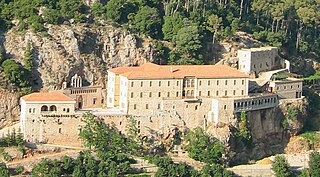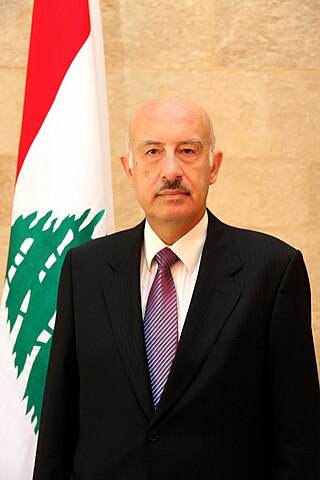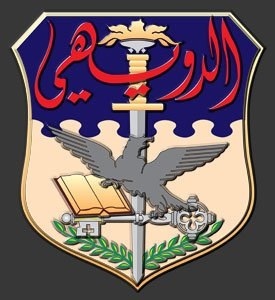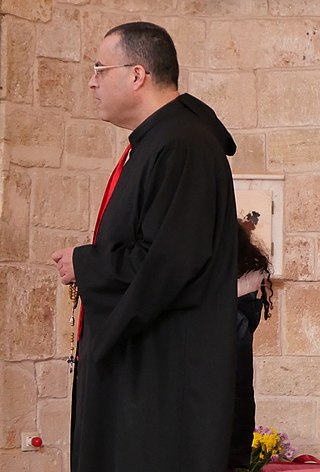
Zgharta, also spelled Zghorta, is a city in North Lebanon, with an estimated population of around 50,000. It is the second biggest city in Northern Lebanon after Tripoli. Zgharta is officially the Zgharta-Ehden municipality.

Kfarsghab is a village located in the Zgharta District in the North Governorate of Lebanon. It is situated in the Valley of Qadisha, which is considered a holy and spiritual place in Eastern Christianity. The main religion of its residents is Maronite Catholicism.

Saint Awtel was a monk in early Christianity venerated in the Middle East. He is celebrated on 3 November, and on 9 October. A church is dedicated to him in the village of Kfarsghab in North-Lebanon where his feast day is celebrated on 3 June and 27 August.

In Ehden, Lebanon, Mar Sarkis is a monastery of the Antonins. It is located in the Zgharta District of the North Governorate, in the Qozhaya valley. It overlooks Ehden, Kfarsghab, Bane and Hadath El Jebbeh. Given its exceptional location commanding the valley at 1500 meters altitude, the monastery is called the Watchful Eye of Qadisha.

Smar Jbeil is a village located in the Batroun District in the North Governorate of Lebanon. It is located on a hill facing the Mediterranean Sea at 500 m elevation. It is one of the oldest villages in Lebanon.
Aitou is a village located in the Zgharta District in the North Governorate of Lebanon. Its population is Maronite Catholic.
The Mariamite Maronite Order, also called the Aleppians or Halabites, is a monastic order in the Levantine Catholic Maronite Church, which from the beginning has been specifically a monastic Church. The order was founded in 1694 in the Monastery of Mart Moura, Ehden, Lebanon, by three Maronite young men from Aleppo, Syria, under the patronage of Patriarch Estephan Douaihy (1670–1704).

The Baladites, formally known as the Lebanese Maronite Order, is a monastic order among the Levant-based, Catholic Maronite Church, which from the beginning has been specifically a monastic Church. The order was founded in 1694 in the Monastery of Mart Moura, Ehden, Lebanon, by three Maronite young men from Aleppo, Syria, under the patronage of Patriarch Estephan El Douaihy (1670–1704).
Ignatius Noah of Lebanon, also known as Nūḥ Pūnīqoyo or Nūḥ al-Bqūfānī, was the Patriarch of Antioch and head of the Syriac Orthodox Church from 1493/1494 until his death in 1509.

Kfarsghab in Zgharta District in the Mount Lebanon Governorate of Lebanon predates Christianity. However, like most villages in the Qadisha valley, Kfarsghab's history began with the settlement of the Maronites in Mount Lebanon during the 10th century. According to local tradition, the church of Saint Awtel was built on the ruins of a pagan temple. The existence of pagan temples is attested to in a Greek inscription mentioning the date 272 AD found in the Mar Mama church in Ehden. The monastery of Mar Sarkis and Bakhos in Ehden may also have been built atop pagan ruins. Given the location of Saint Awtel's Church on a promontory, the existence of a pagan temple in Kfarsghab is plausible.

Salim Bey Karam (Arabic: سليم بك كرم; born on May 21, 1946\ was a Minister of State in the Lebanese government. He was a Member of the 2009-2017 Parliament for the Maronite seat of Zgharta in North Lebanon.
Jacob IV Aouad was a former Eparch of the Maronite Catholic Archeparchy of Tripoli and the 59th Maronite Patriarch of Antioch from 1705 to his death in 1733. In Latin he is called Iacobus Petrus Evodius Hasruensis.
Gabriel II of Blaouza, was the 58th Maronite Patriarch of Antioch from 1704 to his death in 1705.

The House of El Douaihy, is an important Levantine noble family of French origins of which can be traced up until the 7th century. The first prominent feudal northern Lebanese Maronite Sheikhs (Lords) to have governed Zgharta and Ehden, in northern Lebanon came from the Douaihy clan.
Bqarqacha also known as Bkerkasha, is a village located in the Bsharri District in the North Governorate of Lebanon. Bkerkasha overlooks the Holy Valley of Qadisha, a UNESCO World Heritage Site, at its highest western point under mount Lebanon.

The Archeparchy of Beirut is an archeparchial seat of the Maronite Church immediately subject to the Holy See in Lebanon. As of 2012, there were 232,000 baptized. It is currently ruled by Archeparch Paul Abdel Sater.
Gabriel ibn al-Qilai, was a Lebanese Christian religious figure of the Maronite Church. Al-Qilai joined the Franciscan Order in 1470 and was consecrated bishop of the Maronites in Cyprus in 1507.
The al-Dahdah family is a noble Maronite Christian family originating from the village of Aqoura in Mount Lebanon, and whose line of descent is attested since the 14th century. It traces back in continuous lineage to Girgis al-Dahdah, the son-in-law of Ghazal al-Qaysi, Muqaddam of Aqoura, who died in 1375 without male issue.
Tannus ibn Yusuf al-Shidyaq, also transliterated Tannous el-Chidiac, was a Maronite clerk and emissary of the Shihab emirs, the feudal chiefs and tax farmers of Ottoman Mount Lebanon, and a chronicler best known for his work on the noble families of Mount Lebanon, Akhbar al-a'yan fi Jabal Lubnan. He was born in the Keserwan area of Mount Lebanon to a long line of clerks serving the Shihab emirs and other local chieftains. Tannus was taught Arabic and Syriac grammar and throughout his career serving the Shihab emirs and as a merchant, he pursued education in the fields of medicine, jurisprudence, logic, ethics, natural sciences, Turkish and Italian.

Charbel Yusef Abdallah is the Archeparch of the Maronite Catholic Archeparchy of Tyre.












